The one question TEI members most often ask us, the co-chairs of the emerging tax professionals subcommittee, is how to deal with and manage the millennials within their departments and teams. We get asked this question so often, in fact, that the first meeting-in-a-box our subcommittee developed centered on this very topic, generational differences in the workplace. It also happens to be the most popular topic we know of, with several chapters already using the presentation materials and conducting sessions at their chapter and regional meetings. Members struggle with this topic, but they are also passionate about it. We share here a few insights we have gathered on this topic from our research and discussions with TEI members across the globe.
An Unprecedented Challenge
For the first time in history, five generations coexist in the workplace. The five generations, by approximate birth years, are as follows:
- iGen, also known as Generation Z: born 1996 and after;
- millennials, also known as Generation Y: born 1977 to 1995;
- Generation X: born 1965 to 1976;
- baby boomers: born 1946 to 1964; and
- traditionalists: born 1945 and earlier.
Each generation brings its own ideas about work-life balance, communication preferences, career progression, and social values. Managers today must not only understand these generational differences but also learn to leverage each generation’s strengths to create effective and productive teams. In every industry, managers and leaders who can understand, communicate, motivate, train, and retain four or five different generations at the same time are sought after. This multigenerational wrangling is becoming a mission-critical skill, whether you’re in technology, health care, finance, energy, or retail. Managers may not naturally possess this cross-generation skill set, but they can develop it through learning and practice. The generational differences meeting-in-a-box was created to help TEI members develop these skills.
Keys to Cross-Generational Leadership
Some common questions we have seen managers and leaders wrestling with: How should I relate to employees of different age groups? How do I motivate someone much older or much younger than I am? What can you do to encourage employees of different generations to share their knowledge? What do I do about the millennials who don’t want to work as hard as others?
Managers and leaders must first educate themselves about each generation’s characteristics and traits. This not only will help managers to better understand each group but will also dispel stereotypes like “lazy millennials” or “greedy baby boomers who refuse to retire.” Managers should not dwell on differences by assuming that each group needs special treatment. The experts also say that affinity groups are not effective in breaking down barriers, and that conducting generational listening sessions is probably not a good idea. Managers should, however, create opportunities for cross-generation mentoring and cross-generation project teams. These ideas often give employees the opportunity to know each other better and share knowledge more organically.
When it comes to inspiring and incentivizing employees who are much older or much younger than you, it helps to think like an anthropologist. According to the Harvard Review, you should consider where your employees are in their lives and what their needs are. For example, younger employees typically don’t have many outside obligations; workwise, they are motivated by new experiences and opportunities. Employees in their thirties and forties, on the other hand, often have children and mortgages and want flexibility, additional pay, and advancement. Workers at the end of their careers might not be as interested in training, but they do want interesting work and work-life balance.
To learn more about how to manage the different generations, encourage your chapter to consider having an ETP subcommittee member deliver the generational differences presentation.
Emily Whittenburg and Kris Rogers are co-chairs of the emerging tax professionals subcommittee.




